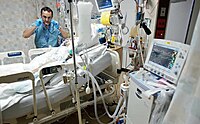
Photo from wikipedia
Introduction/Hypothesis: Emergency airway events occur frequently outside of units with critical care resources and a high mortality rate has been observed at our institution. However, there is a paucity of… Click to show full abstract
Introduction/Hypothesis: Emergency airway events occur frequently outside of units with critical care resources and a high mortality rate has been observed at our institution. However, there is a paucity of literature on the epidemiology and outcomes associated with these events. This study was conducted to measure the institutional incidence and outcomes of these events, to identify patient characteristics associated with the events and to determine risk factors associated with poor outcomes. Methods: This is a single-center, retrospective, observational cohort study of emergency airway events that occurred in admitted patients outside of units with critical care capabilities at Dartmouth-Hitchcock Medical Center from July 2011 to December 2017. Patient demographics, comorbidities, event details and patient outcomes were extracted from the electronic medical record and the life safety/rescue database, in addition to a two person review of the event and procedure notes. Results: A total of 266 emergency airway events qualified for our study with an average 41 events annually. 45% of events occurred in females and the average patient age was 67 years old. The overall mortality rate was 38%. A critical care nurse was consulted prior to event activation in 63% of events, 46% of events were an escalation of an emergency response team activation and 17% of events were called during a Code Blue. 81% of events required patient intubation with the most common indication being airway protection. Intubation was typically uneventful with 89% of events requiring only 1 intubation attempt. Cardiac arrest was the most common event complication and was associated with 11% of events. Our logistic regression model showed that age was significantly associated with increased odds of mortality with a 3.4% increase for every additional year. The mortality rate for an emergency airway event without an associated code blue activation was 36.4%, this significantly increased to 56.7% when the event was activated along with a code blue activation (p= 0.03). Conclusions: Despite often uncomplicated intubations, emergency airway events have a 38% mortality when they occur outside of units with critical care capabilities. Risk of mortality was associated with patient characteristics, such as age, and with code blue activations.
Journal Title: Critical Care Medicine
Year Published: 2020
Link to full text (if available)
Share on Social Media: Sign Up to like & get
recommendations!